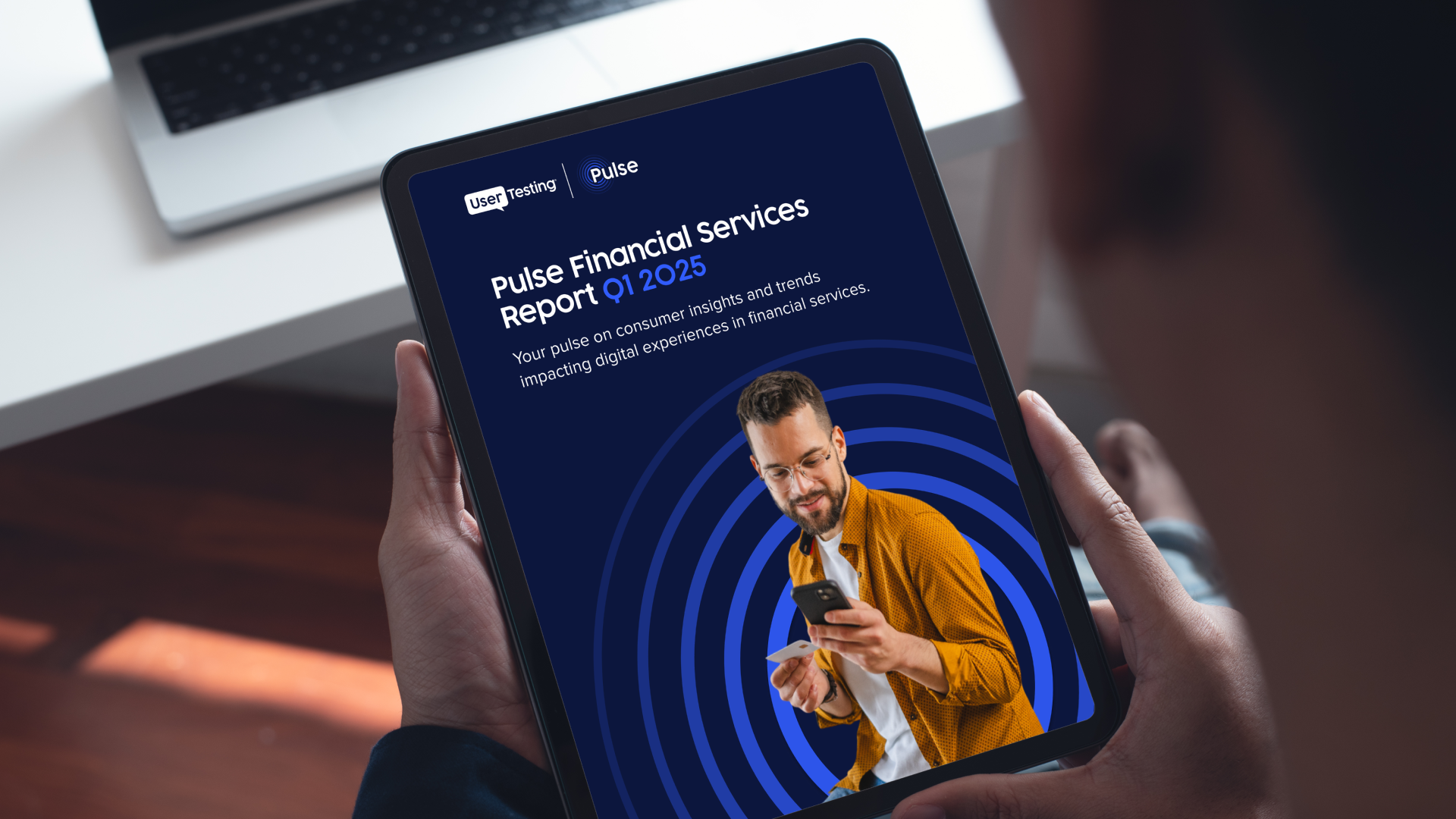
Financial services usability testing

Financial service organizations face unique challenges when conducting usability testing, from strict regulations and privacy concerns to being new to usability testing. However, this shouldn’t dissuade your teams from doing frequent studies, especially when customer loyalty and growth potential are on the line, among other factors.
In an ever-evolving field that’s experiencing increased digitalization, tighter data security, and the prioritizing of AI, teams can’t afford to not know what their customers are thinking and risk the experience gap.
Rob Krugman, Chief Digital Officer at Broadridge tells UserTesting,
Consumers—they choose to do what they want. If you start with the need of the consumer and work backward, you tend to be in a much better location. It’s about solving the problem even though the customer may not know they have it.
Sharon Meaney, Senior User Researcher at Wells Fargo, adds to this sentiment, “Getting the customer voice to where it needs to go is super important. Make sure it permeates your organization and that your business team, product owners, and design teams are all on board and setting a customer-centric KPI. It’s getting that voice infused throughout your organization, so you’re not operating out of a silo or vacuum.”
Below are the tips and tricks to remember when conducting user testing for your financial service, whether you’re gearing up for your first study or your hundredth.
1. Be patient and think (way) ahead
No matter how progressive a financial institution may be, all of them will have a lot of regulatory considerations. As a result, additional precautions and approvals must be taken, requiring projects to be planned out far in advance. Building a research interval after each iteration from the get-go is critical. The benefit of this step is that your team will know exactly what to expect and can prepare.
Be sure your teams have thought through all the details and considerations for every test plan so there are no surprises or delays when it’s time to start testing. It can be tough to react quickly when regulation is such an important part of the business, so staying patient and thinking ahead will save you and your team a lot of frustration. Additionally, establishing benchmarks before and after changes will help build team alignment and focus.
2. Ask the right questions at the right time
Remember that asking your customers for feedback is only half of the equation. If you’re not asking the right questions, you won’t necessarily be nearing solutions. And, of course, the right questions must be asked at the right time. Before fully developing your product, spend time understanding your customers’ needs and frustrations. If you’re in the prototyping stage, collect user feedback as soon as you have a wireframe. And even after a new feature, product, or campaign has launched, keep monitoring feedback to help guide decisions on functionality or features you need to add or remove. To get started, use the following questions, categorized by different focuses, as inspiration.
Understanding user background:
- Share as much as you’re comfortable about your income. What income streams do you have?
- Describe how you use your financial service’s digital tools.
Measuring brand impression:
- Do you think your bank understands you? Why or why not?
- Are you loyal to your financial service? Why or why not?
- What are three words you’d use to describe your bank?
- Would you recommend your financial service to friends or family?
Gathering feedback on in-branch experiences:
- How would you describe your most recent visit to your bank?
- What did you like about your recent in-person visit?
- What did you dislike about your recent in-person visit?
Optimizing digital experiences:
- How would you improve your bank’s mobile app?
- Rate the consistency of your financial service’s mobile experience versus online.
Below, watch the following highlight reel on what contributors had to say when asked if they feel their bank understands them.

3. Collaborate with other teams and get all necessary approvals beforehand
Sometimes study plans can get caught up in legal review, adding time to the overall testing process. Consider creating a resource of standard questions your team can use for tests and have the legal team review them simultaneously and give pre-approval. Typically, as long as your team sticks to the pre-approved questions and plans, the legal team will be less likely to cause a testing bottleneck.
If you’re stuck on developing the right questions or test structure, visit the UserTesting template gallery to find research expert-designed questions suitable for any industry or need.
4. Know how to manage customer privacy
One of the biggest challenges for financial service organizations is maintaining their customers’ privacy. That can lead to hesitation when user testing any client-facing app or site. For this reason, with the UserTesting platform, organizations must follow the best practices for personally identifiable information (PII), which also offers contributors peace of mind. Test participants can’t disclose credit card numbers, financial account numbers, or account passwords, to name a few.
Maggie Young, a CX evangelist who led the digital customer experience initiative at Citibank, says privacy concerns can be easily mitigated by establishing proper blind prototypes, secure testing protocols, or sandbox environments for users to test in.
Some best practices include:
- Offering contributors false information to use during tasks
- Using UserTesting’s Blur Tool will conceal personal information like names, account logins, and addresses
- Using screener questions to set expectations and give contributors an opportunity to opt out
Additionally, ensuring you collaborate with departments across your organization can help. These environments are typically managed by your IT, development, and design teams, who can help you create mock accounts or prototypes that won’t link to any real customer data as long as they’re included in the kick-off. Including information security team members in early discussions can reduce or remove possible future problems, too. Getting to know those teams and keeping them continually updated will make setting up those environments much easier and help calm any nerves about customer privacy. Sharing results with those teams will also close the loop and build strong relationships.
5. Remember that there’s a human behind the data
Quantitative data will always be an important component of research and even more so in the financial space. It’s crucial to find ways to humanize that data regularly. To do this, piggyback on the common practice teams have of watching highlight reels—positive or negative. This step also shows customers using the app and site and puts a human being on the other end of all the data. Here at UserTesting, we call these “viewing parties,” where teams and stakeholders can gather and watch feedback—and nothing gets lost in translation. Turning viewing parties into a consistent habit leads to internal dispute resolution, customer-centric product development, and the validation of user testing.

Pulse Report: Financial Services, Q1 2025
In this quarterly Pulse Report, learn more about the rising demand for streamlined digital banking experiences.





